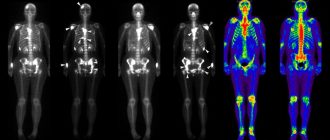The normal size of the prostate gland in adults on ultrasound may indicate the normal development and functioning of the genitourinary system. Changes, on the contrary, make it possible to determine the presence of a pathological process. Therefore, ultrasound of the prostate is considered to be a rather important examination; with its help, in addition to linear dimensions and volume, contours, uniformity of tissue structure and other indicators of the organ are analyzed.
Age-related changes
The prostate grows throughout life. Reaches normal size by age 25. After 40 years, age-related changes are possible that contribute to further growth, but they must comply with the norms.
Normal indicators of the prostate gland during ultrasound examination:
- length 3 cm;
- width 3 cm;
- thickness 2 cm.
The normal volume of the prostate gland is 20 - 30 cubic meters. cm.
With age, indicators may change. If a significant increase occurs in a short period, this can only be explained by the onset of the disease.
What parameters are determined by ultrasound of the prostate?
Interpretation of the results of ultrasound of the prostate gland includes consideration of the following parameters:
- Contours and symmetry. Normally, the prostate looks like a chestnut divided into 2 equal parts by the urethra. Visually, it should have clear contours and a symmetrical arrangement of the halves relative to the urethra.
- Dimensions. Must meet normal age standards. However, linear characteristics (length, width, thickness) may differ in each individual case, so they are used to calculate the volume, which is easier to compare with the norm.
- Homogeneity of structure (echogenicity). Determined by the tissue’s ability to reflect ultrasonic waves. Any deviations in the echogram of the prostate gland indicate a change in tissue density. This happens in the presence of an inflammatory process, tissue scarring, edema, benign or malignant tumor.
- Amount of residual urine. It is determined when the procedure is repeated after emptying the bladder. If a significant amount of residue is detected, we can talk about the development of pathologies.
- Vascularization. This is the process of formation of blood vessels. It occurs as a result of stagnation of blood in one part and excess blood supply to another area.
Calculation of prostate volume
Measurement of the prostate gland on ultrasound occurs by determining the linear parameters of the organ. The transverse part (width-A), top-bottom size (length-C) and anterior-rear (thickness-B) are measured. The most accurate readings are obtained with transrectal diagnosis.
To determine the volume of the prostate gland using ultrasound, doctors use the truncated ellipse formula. The resulting measurements (length, width and thickness) are multiplied by 0.52.
For example, V = A * B * C * 0.52.
If the weight is less than 80 g, the formula V = A2 * B * 0.52 applies.
When weighing more than 80 g, use the formula V = A3 * 0.52.
In order to calculate the volume of the prostate using the formula for ultrasound, depending on age, you need to use Dr. Gromov’s formula: V = 0.13*B + 16.4 (V – volume, B – patient’s age).
For example, a 45-year-old man: 0.13*45 +16.4= 22.25 ml.
Table of normal prostate sizes in men by age
Sometimes the parameters may be different; this may be an individual feature of the structure of the genital organs and must be confirmed by doctors. Acceptable limits of linear dimensions on prostate ultrasound:
- width 22 – 40 mm;
- length 25 – 45 mm;
- thickness 15 – 23 mm.
Since linear dimensions may differ among different people and at different ages, volume is calculated with their help.
Table of normal prostate sizes by age on ultrasound:
| Age, years | Volume, ml |
| 20 – 30
30 – 40 40 – 50 50 – 60 |
19 – 23
20,3 – 24,5 21,3 – 25,75 26 – 30 |
Normal and abnormal prostate glands on ultrasound cannot be accurately interpreted as diseases. Sometimes diseases, especially in the initial stages, are asymptomatic. In some cases, deviations from normal sizes can be explained by the individual characteristics of the body. They can be either decreasing or increasing.
What complications do deviations indicate?
During the examination, an increase in size is most often determined. Most often this indicates:
- development of a benign or malignant tumor;
- formation of cysts and stones in the prostate;
- prostatitis.
There are cases of organ shrinkage. Very rarely, prostate atrophy can be caused by congenital abnormalities. In this case, other organs of the genitourinary system are also underdeveloped.
Basically, these changes appear when:
- chronic diseases that cause insufficient blood supply to the organ;
- prostate injuries;
- vascular sclerosis of the genitourinary system;
- spinal injuries;
- stones in the bladder or urethra that cause pressure.
The conclusion obtained from prostate ultrasound cannot be the only basis for making a diagnosis. In order to have a complete picture of the disease, it is necessary to undergo additional laboratory tests. Only after this can an accurate diagnosis be established and full treatment prescribed.



